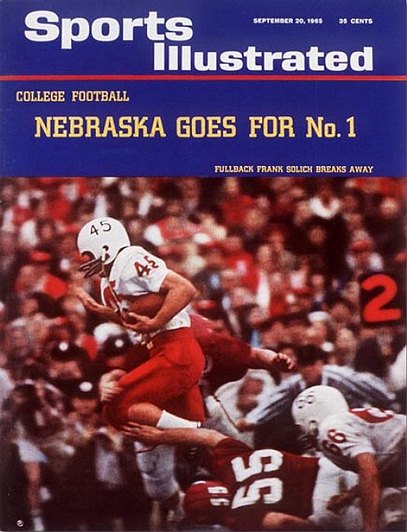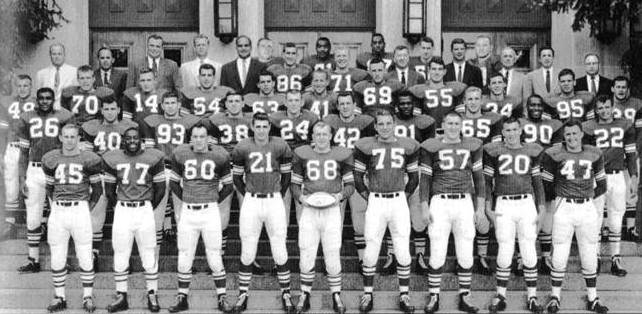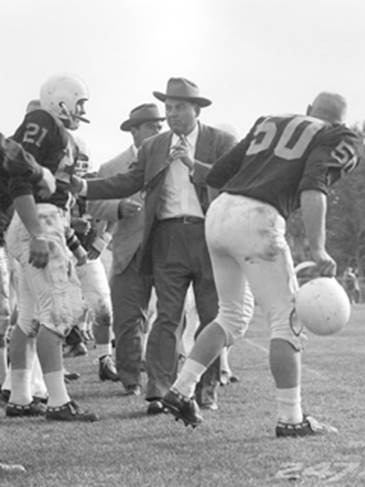

BOB DEVANEY AND HIS CORNHUSKERS, PART ONE
HELMET HUT NEWS/REFLECTIONS June 2015:
BOB DEVANEY AND HIS CORNHUSKERS, PART ONE
By Dr. Ken
With absolutely no disrespect
intended towards the football
program at the University Of
Nebraska-Lincoln, where is its
relevancy? If asked “Are the
Nebraska Cornhuskers ‘good?’” by
any measure, the answer is
“Yes.” However, this was a
football program far better than
“good” and for decades, had to
be considered when talking about
a possible national champion or
Top Ten team pre-season,
in-season, or post-season
ranking. Now, faithful Huskers
followers of the current
generation may not even be aware
of the status and clout that NU
enjoyed in past decades. This is
not to state that the program
has fallen into the type of
disrepair that would make anyone
believe it is on par with the
Idahos, Eastern Michigans, or
New Mexico States, but the
Huskers of the latter part of
the Twentieth Century were
elite.
 |
Fullback Frank Solich was featured on Sports Illustrated’s College Football Preview issue in September 1965. This photo and the feature within the pages of the magazine put the Nebraska program and Solich, the current head coach at Ohio University, onto the national landscape of college football
Every era provides college football fans with a few coaches who stand out from among the rest. One or two will become legendary based upon their overall record, victories over significant opponents, number of conference and/or national championships, and All American players they develop. It has always been this way and each generation no doubt believes that they were more fortunate than others in being able to “live the game” during the reign of a particular coach or group of coaches. The man who provided relevancy to Nebraska football was Bob Devaney. For reasons not understood by this author, Devaney’s name is not often mentioned when discussing the great collegiate football coaches of the past, or of his generation of coaches. Bryant, Robinson, Royal, Paterno, Wilkinson, Broyles, Osborne, Blaik, Hayes, Schembechler, Parseghian,and Dodd are often the men noted for being outstanding in the mid-1900’s and each has earned a distinction that certainly confirms their place in college football’s history and in the College Football Hall Of Fame. Bob Devaney is not one of the names that is immediately put forth as one of the all-time greats and he should be. It should also be recalled that Devaney was not a typical football coach coming from a background that included previous playing stardom or a burning desire to coach and mentor young men.
A product of the depression
era and Saginaw, Michigan,
Devaney played high school
football, basketball, and
baseball but excelled at
none of these endeavors and
was not “scholarship
material.” He instead
graduated in 1933 and began
the difficult physical work
that came with a job at the
Chevrolet foundry. He looked
to an uncle who was an
accountant and decided that
he would be far less
exhausted at the end of the
work day in a job that was
similar. He enrolled at Alma
College, approximately forty
miles from his Saginaw home,
and toiled as a waiter and
gas station attendant to pay
his tuition and support his
wife. He became an All
Conference end and team
captain and was convinced by
his college coach to accrue
education credits so that he
could teach high school
business courses and coach
football. Devaney
single-mindedly pursued this
course of action and began a
lengthy journey through the
Michigan high school ranks,
teaching up to six subjects
per day and coaching
multiple sports. In 1953 at
the age of thirty-seven,
having settled into a life
of a typical high school
teacher and coach, he looked
back on his recent coaching
record at Alpena High School
and realized that he could
be satisfied with the
success that comes with
winning fifty-two of his
last sixty-one games.
Devaney had given thought to
becoming a college coach but
with no offers tendered, as
he said, “I was
thirty-seven. If a break
didn’t come before I was
forty, I was going to go
back and get my masters and
take a boring administrative
job somewhere.”
 |
The break did in fact come
with a phone call from
Michigan State line coach
Hugh “Duffy” Daugherty who
offered Devaney an
assistant’s position on Head
Coach Biggie Munn’s staff,
coaching ends and defensive
backs. The Spartans were
quite successful in three of
the four seasons that
Devaney served as a Michigan
State assistant and he was
named as Wyoming’s head man
for the ’57 season. His
arrival at Wyoming was due
to a bit of luck, luck seen
as “bad luck” by Devaney at
the time. Missouri head
coach and athletic director
Don Faurot had promised
Devaney the head coaching
job at Mizzou after the 1956
season, upon Faurot’s
retirement from the coaching
ranks. He went as far as to
instruct Devaney to
“assemble your staff” but
before a contract was
finalized, Missouri hired
Frank Broyles. Faurot later
explained that the decision
was “out of (his) hands” but
as an acclaimed, long time
head coach and the AD, this
explanation did not hold up
well to public scrutiny.
Broyles left Missouri for a
storied career at Arkansas
after but one season, and
Devaney was supposedly again
on Mizzou’s radar but there
was no negotiation and
Devaney had, in one season,
firmly established himself
at Wyoming.
As Devaney remarked
a number of times,
“I learned to love
Wyoming. They wanted
to win at Wyoming.”
The university
president was
sympathetic to the
difficulties of
attracting talented
athletes to Laramie,
Wyoming, which in
the 1950’s, was
considered little
more than a frontier
outpost. Devaney was
an excellent
recruiter in part
because he was a
genuinely nice
person, well-liked
by those in the
State of Wyoming,
those he worked
with, those who
worked for him, and
the families of the
players he
recruited. Dr.
George Duke “G.D.”
Humphrey had been
the University Of
Wyoming President
since 1945 and
understood that a
viable football
program would
elevate the public’s
awareness of his
university. As a
native of Tippah
County, Mississippi,
a graduate of what
was later named the
University Of
Southern
Mississippi, and an
ardent football fan
who had grown up in
the south, he had
exposure to what had
been rather rampant
“Pay-For-Play”
shenanigans. He was
also highly educated
and intelligent and
knew what would be
necessary for
football success and
thus he allowed for
a rather lenient
admissions policy
for some players.
The result was a
rapid ascension of
the program but a
1957 season of
violations resulted
in a one year period
of probation, from
1959 – 1960 with a
bowl ban in ’59.
The Devaney Era at
Wyoming got off to
what insiders saw as
a rocky start,
following former
head coach Phil
Dickens who was
Rocky Mountain Coach
Of The Year in both
1955 and ’56. His
four years at
Laramie were quite
successful, with the
10-0 record of ’56
leading to the job
at Indiana
University.
Devaney’s 4-3-3
record, despite
solid and exciting
play behind a new
Multiple Offense was
interpreted as a
step back. However,
Devaney knew how he
wanted to build his
team, and did so.
With only
twenty-seven high
schools within the
state playing eleven
man football, the
staff knew that they
would have to look
for players far and
wide and they did.
From 1957 through
’61 Devaney compiled
a 35-10-5 mark with
a victory in the
1958 Sun Bowl. In
five seasons he won
or shared the
Skyline Conference
Championship four
times with two
National Top Twenty
finishes, a
remarkable
achievement for
Wyoming. It was
often said that even
to the late 1960’s
when Devaney would
be on the road
recruiting with his
Nebraska assistants,
the talk often
referenced events at
Wyoming and the
wonderful time he
and his family spent
there. No one
doubted that he
liked the state, its
people, the school
setting despite its
relative isolation,
and those he worked
with but his
ultimate coaching
success would have
been limited. As was
stated decades later
by a member of the
Wyoming athletic
department, “The
best he (Devaney)
could have hoped for
would have been to
achieve what BYU
eventually did. BYU
has a terrific
program and won a
National
Championship (in
1984) but they could
not compete for that
title or at that
level consistently.
They could dominate
our area but Bob had
the ability to
compete annually.”
Devaney’s staff
obviously agreed.
When he accepted the
Wyoming job and left
Michigan State, he
brought a number of
coaching associates
from the State of
Michigan with him.
Jim Ross had been a
long time friend and
he and Devaney
shared coaching
duties at Alpena
High School with
Ross the head
basketball coach and
Devaney the head
football coach. Each
served as the
other’s assistant.
Both had been quite
successful with
Devaney undefeated
in his first two
seasons of high
school coaching.
Mike Corgan also was
a solid high school
mentor. Devaney
hired Carl Selmer
from Worland,
Wyoming and John
Melton, a former
Wyoming Cowboys
fullback and high
school coach at
Thermopolis,
Wyoming. The latter
two knew the
territory well and
immediately
reinforced the
philosophy that
Wyoming would be
successful only if
they went out of
state to procure
talent.

Devaney gets his
Wyoming Cowboys in
winning position